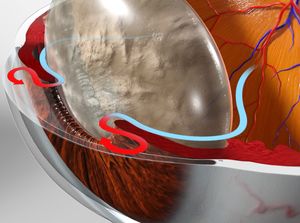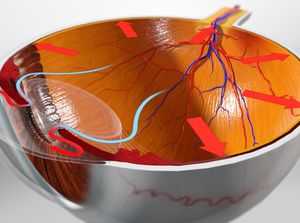Glaucoma
Glaucoma is an eye disease in which the optic nerve – the part of the eye that carries the images we see to the brain – is damaged. The optic nerve contains many small nerve fibers that are very sensitive to pressure changes inside the eye. If the intra-ocular pressure (pressure inside the eye) exceeds a critical level (which may be different for each person), damage to the optic nerve begins. Once destroyed, these nerve fibers cannot regenerate. This can lead to permanent vision deficits such as blind spots, visual field defects or even complete blindness. Early detection and control of intra-ocular pressure are the keys to preventing optic nerve damage and blindness from glaucoma.

View Video:
Glaucoma (Angle Closure Type)

View Video:
Glaucoma (Open-Angle Type)
Causes
There is a fluid produced by a part of the iris called the ciliary body that fills the front portion of the eye (the anterior chamber). This fluid is known as the aqueous humor. Aqueous humor is produced at a constant rate by the ciliary body, where it circulates through the anterior chamber then flows out of the eye at the same rate through the drainage angle (area between the iris and cornea). This steady state of aqueous humor flow keeps the pressure in the eye relatively constant. If, however, the rate of flow out of the eye decreases (from blockage of the drainage angle), the continual influx of aqueous humor will cause the pressure inside the eye to increase exponentially, causing damage to the optic nerve.
Types
The type of glaucoma is related to the way in which the drainage angle is blocked. Chronic open-angle glaucoma, the most common form, arises when the drainage angle becomes inefficient at allowing fluid flow from the eye. The pressure gradually increases over time, and damage to the optic nerve is slow and progressive. The damage is so slow and painless that there are no noticeable symptoms until the optic nerve is significantly damaged. The risk of open-angle glaucoma increases with age, and treatment is aimed at lowering the intra-ocular pressure through eye drops, laser or surgery.
The other type of glaucoma, angle closure glaucoma, occurs when the drainage angle is completely blocked by the iris. This can cause a sudden increase in intra-ocular pressure leading to blurred vision, severe eye pain, headache, nausea or vomiting and halos (colored) around lights. This is known as an acute angle-closure attack, and represents a true eye emergency. Blindness from this type of glaucoma can occur rapidly, sometimes within hours if not treated. Angle-closure glaucoma is seen more often in people with smaller (farsighted) eyes and those of Caucasian heritage, but relatively uncommon with respect to chronic open angle glaucoma. Treatment usually involves laser surgery and eye drops.
Risk of glaucoma
Although there are many factors that contribute to the risk or likelihood of developing glaucoma, the three with the most significance include, age, family history and past eye injuries. But everyone, despite presence or absence of risk factors, should be screened for glaucoma regularly.
Treatment
Treatment depends on the type and severity of the glaucoma and may include eye drops, laser or surgery. All are aimed at lowering the pressure and preserving optic nerve function and vision.
Detection
The best way to detect glaucoma is with regular eye examinations by an ophthalmologist. Complete evaluation should include dilated examination of the retina (ophthalmoscopy), inspection of the drainage angle (gonioscopy), measurement of intra-ocular pressure (tonometry), measurement of the corneal thickness (pachymetry) and testing of the peripheral visual field of each eye (perimetry). All are necessary to detect and treat glaucoma.
